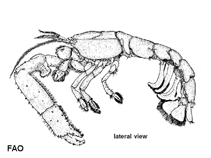Neotrypaea gigas (Dana, 1852)
Giant ghost shrimp| Native range | All suitable habitat | Point map | Year 2050 |

|
| This map was computer-generated and has not yet been reviewed. |
| Neotrypaea gigas AquaMaps Data sources: GBIF OBIS |
Classification / Names Common names | Synonyms | CoL | ITIS | WoRMS
Malacostraca | Decapoda | Callianassidae
Environment: milieu / climate zone / depth range / distribution range Ecology
Benthic; brackish. Temperate; 51°N - 29°N, 129°W - 115°W (Ref. 4)
Distribution Countries | FAO areas | Ecosystems | Occurrences | Introductions
Eastern Pacific. Climate: subtropical to temperate.
Length at first maturity / Size / Weight / Age
Maturity: Lm ? range ? - ? cmCommon length : 15.0 cm TL male/unsexed; (Ref. 4)
Short description Morphology
Rostrum a low median angle on the anterior margin of the carapace. Eyes elongate triangularly pointed, reaching with their full length beyond the rostrum. Antennal angles blunt, without spine. Antennal peduncle practically as long as the antennular peduncle. Third maxilliped with merus and ischium strongly expanded forming operculum; the last three segments of the maxilliped less than half as wide as the merus, but not very slender, twice less than twice as long as wide. Large chela of adult male with the concave part of the anterior margin of the part above the base of the fixed finger absent or hardly noticeable. Carpus distinctly longer than palm. Merus with a large and rather wode hook-shaped process in the basal part of the lower margin; in the female this process is reduced to a small triangular tooth. Telson quadrangular, longer than wide and slightly narrowing posteriorly; posterolateral angles rounded. Posterior margin with a small triangular median denticle; no other spines or teeth on telson. Endopod of uropod broad, quadrangular or slightly triangular, with rounded angles and slightly longer than telson (Ref. 4).
Assumed total body length is 12.5 to 15 cm. Habitat: In lower intertidal zone of tidal flats on the sea coast and in estuaries. Behavior: It burrows in soft substrate of sand and mud (Ref. 4).
Life cycle and mating behavior Maturity | Reproduction | Spawning | Eggs | Fecundity | Larvae
Members of the order Decapoda are mostly gonochoric. Mating behavior: Precopulatory courtship ritual is common (through olfactory and tactile cues); usually indirect sperm transfer.
Main reference
References | Coordinator | Collaborators
Holthuis, L.B. 1991. (Ref. 4)
IUCN Red List Status (Ref. 130435)
CITES status (Ref. 108899)
Not Evaluated
CMS (Ref. 116361)
Not Evaluated
Threat to humans
Human uses
Bait: usually
| FishSource |
Tools
More information
Internet sources
BHL | BOLD Systems | CISTI | DiscoverLife | FAO(Publication : search) | Fishipedia | GenBank (genome, nucleotide) | GloBI | Gomexsi | Google Books | Google Scholar | Google | PubMed | Tree of Life | Wikipedia (Go, Search) | Zoological Record
Estimates based on models
Preferred temperature
(Ref. 115969): 12.4 - 18.2, mean 15.4 (based on 40 cells).
Price category
(Ref. 80766):
Unknown.



